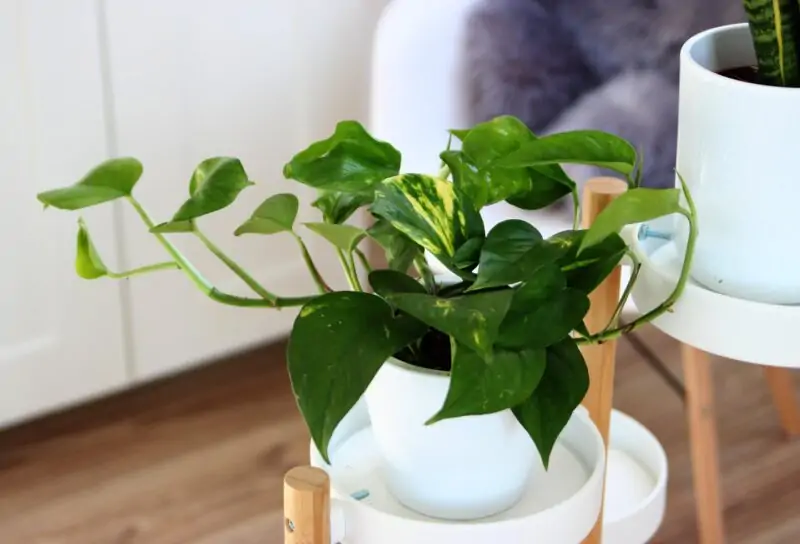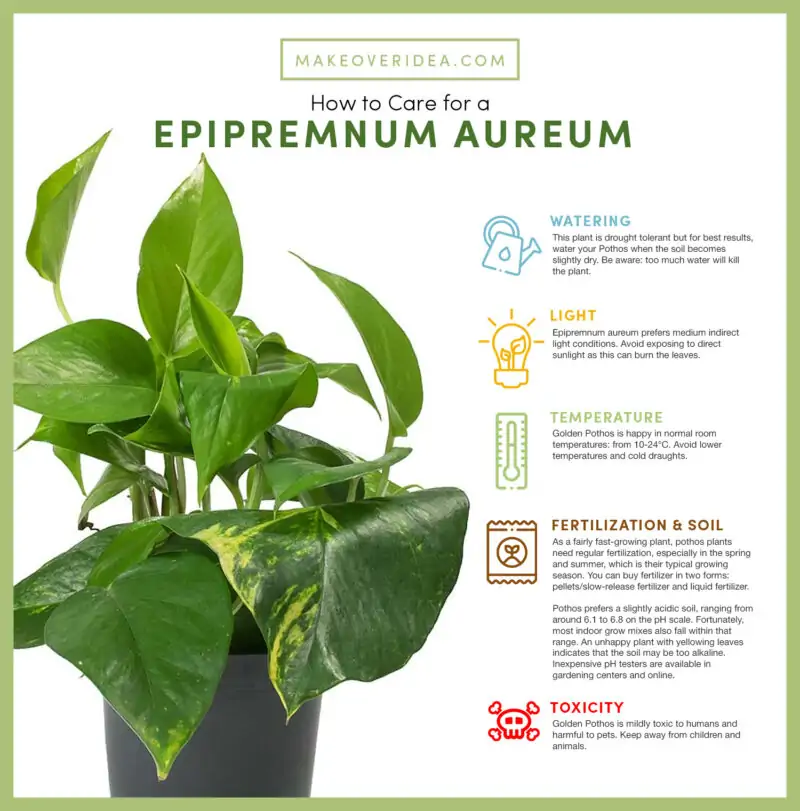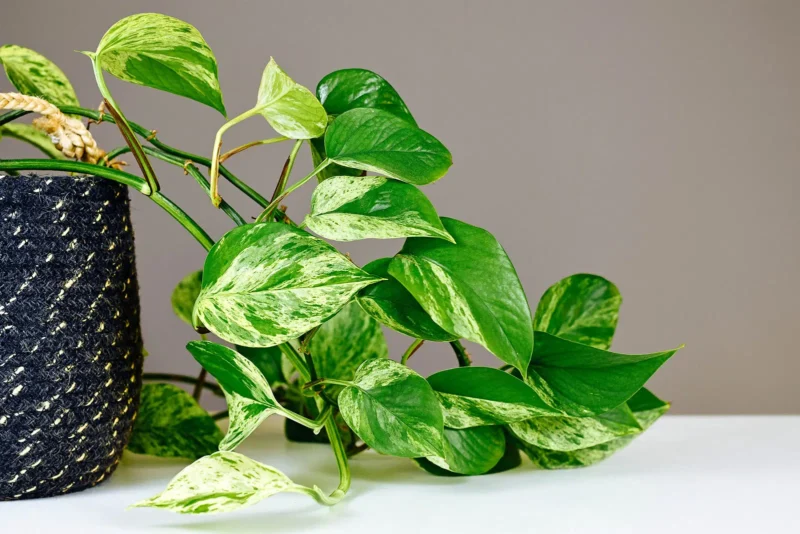Growing Epipremnum Aureum: Care Tips for Golden Pothos Plant

Are you looking for a low-maintenance houseplant that can add life to your living room without too much effort? Then look no further than Epipremnum Aureum: care for this plant is remarkably easy!
Also known by its common name Pothos plant, this trailing vine with heart-shaped leaves resembles ivy in some ways. Pothos is a perfect choice for beginners, those with limited space and time, or just anyone who wants a touch of greenery in their home. In this article, we will guide you through the essentials of Pothos plant care and provide some useful tips on how to grow it successfully.
Epipremnum Aureum: An Overview
Natural Habitat and Description
Epipremnum aureum is native to French Polynesia but has since been naturalized in other parts of the world, including Southeast Asia, where it thrives best under tropical climates. It belongs to the Araceae family, which includes popular indoor plants such as Peace Lilies (Spathiphyllum) and Monsteras (Monstera deliciosa).
Pothos features long stems that trail gracefully over pots or hanging baskets, covered by glossy evergreen green leaves shaped like hearts that are usually variegated with yellowish-white spots, giving them an eye-catching look.
Invasive Nature of Pothos
As mentioned earlier, Pothos is indigenous species from southeastern Asia; however, they’re now so widespread throughout temperate regions worldwide due not only because they’re attractive ornamentals but also because they’re very easygoing, especially regarding light conditions needing minimal watering & fertilizing, making them quite appealing both indoors and outdoors, provided there’s enough shade available most times during hot summer seasons!
Despite its apparent benefits, Pothos is known to cause damage to the environment by out-competing local vegetation, causing soil erosion, leading to habitat modification, and spreading hazardous invasive pathogens. Make sure to dispose of unwanted portions properly, otherwise, you risk contamination of groundwater systems and adjacent ecosystems!
Pothos Care Tips

Growing a healthy pothos plant is easy as long as you provide it with the right growing conditions. Here are some key points to keep in mind when caring for your Epipremnum Aureum:
Light Requirements
Pothos plants can tolerate a wide range of light conditions, including lower light levels. Still, they thrive best in bright, indirect light. Avoid direct sun which may damage the leaves of the plant by scorching them.
Temperature and Humidity
Epipremnum Aureum prefers warm temperature ranges between 60-85°F (15-30°C). They grow well under normal household humidity levels maintained above 40%, so misting their foliage regularly might help increase moisture levels around it and improve its overall health!
Watering Epipremnum Aureum
Water pothos only when the soil feels dry to the touch, about an inch below the surface level; overwatering may lead to root rot! Ensure drainage holes on pots allow excess water to escape immediately once saturated. Otherwise, remove standing water from saucers beneath the pot’s bottom to prevent stagnant build-up that promotes fungal growth, causing more harm than good eventually. When it comes to waterings, the most important rule is not to overwater.
Soil and Potting Mix
Use well-draining, fertile soils mixed with coarse sand, perlite, peat moss, etc., or better yet, use pre-mixed commercial potting mixtures containing all necessary nutrients already blended together, meeting specific plant requirements promoting healthy development, including faster rooting, stem elongation, and rapid leaf formation, etc.
Fertilizing and Feeding
Feed every two weeks during spring and summer months using balanced liquid fertilizers diluted according to instructions provided on the packaging, often concentrated requiring proper mixing before application, making sure speed-sprayers deliver even distribution across the entire canopy without leaving out any portion untreated, exposing areas to nutrient deficiencies, lack of vigor,
Soil and Potting Mix
For a healthy Epipremnum Aureum, use well-draining, fertile soil mixed with coarse sand, perlite, and peat moss. Alternatively, opt for a pre-mixed commercial potting mixture, which contains all the necessary nutrients for your plant. This promotes healthy development, including faster rooting, stem elongation, and rapid leaf formation.
Fertilizing and Feeding
During the spring and summer months, feed your pothos every two weeks using a balanced liquid fertilizer, diluted according to the instructions provided on the packaging. Ensure even distribution across the entire canopy, avoiding untreated areas that may be exposed to nutrient deficiencies and other issues.
Types of Pothos: Marble Queen
While there are many different varieties of Pothos available, we will focus on the Marble Queen variety, which is popular among gardeners and plant enthusiasts.
This stunning variety of pothos boasts white and green variegation on the leaves. They can grow up to 6 feet long when fully mature, making them perfect for hanging baskets or training along walls as trailing stems, providing an attractive highlight either indoors or outdoors.

Other Common Varieties
Other common types of Epipremnum Aureum include Golden Pothos (also known as ‘Devil’s Ivy’ and “Money Plant”), Manjula Pothos, and Neon Pothos. All of these share similar care requirements, with differences in color patterns, size, and growth rates. Choose the variety that best suits your preferences!
Potting, Repotting, and Staking Pothos
Potted plants require proper pot selection, considering factors such as planter shape, material, style, drainage hole availability, and size matching the root ball volume to prevent excessive soil moisture retention that can lead to rot development.
Choosing the Right Pot
When choosing a pot for your Epipremnum Aureum, ensure it has good drainage holes at the bottom, allowing excess water to escape once saturated. Remove standing water from saucers beneath the pot to prevent stagnant build-up that promotes fungal growth, potentially damaging the foliage and stems.
The ideal container should be several inches larger than the previous one, providing enough room for root ball expansion and accommodating new leaf formation, increased height, and better nutrient distribution.
Repotting Guidelines
Repot your pothos every 2-3 years or when you notice roots emerging from the drainage holes. Be careful not to damage the delicate roots in the process.
Staking: Pros and Cons
Staking can train your Pothos plant into a specific shape, but it may cause stress on stems and eventually lose their natural trailing habit. A better solution might be hanging baskets or placing pots on shelves, providing adequate support without interfering with normal growth patterns.
Pruning and Propagation
How to Prune Epipremnum Aureum
Pruning your pothos plant is important to keep it looking healthy and vibrant. Trimming the stems encourages new growth, making your plant fuller over time. Use a clean pair of sharp scissors or pruning shears and cut at an angle away from the main stem to prevent water from pooling on the cut surface.
Propagation Techniques
Pothos plants are easy to propagate using these methods:
- Stem Cuttings: Take 4-6 inch-long stem cuttings just below a node or leaf joint with several leaves attached. Remove any lower leaves that may be submerged when rooting. Root them in soil or water before planting them directly into the potting mix.
- Leaf Cuttings: Propagate using individual leaves trimmed off near their base, submerged halfway in shallow moist soil. Once roots form, transfer these rooted portions individually into small pots filled with fresh potting mixture.
Pothos: Problems and Solutions
Common Issues and Their Causes
Although pothos plants require minimal care compared to other houseplants, they can occasionally face a few issues.
Overwatering
The most common issue faced while growing Epipremnum aureum is overwatering, leading to root rot, curled-up wilted foliage, etc., due to improper drainage holes or insufficient watering frequency.
Under-watering
Underwatering leads to wilting, dryness (brown tips), and stunted growth.
Low Light Conditions
If placed under direct sunlight, the leaves can burn or scorch. In contrast, if placed under low light conditions, the plant tends to grow leggy, with sparse foliage and thinning stems.
Troubleshooting Tips
If your pothos is showing signs of distress:
- Check for pests such as mealybugs, spider mites, or scale insects. You may need to use an insecticide spray specifically designed for houseplants.
- Review watering habits – too much water could lead to root rot, while too little water would make it droop.
- Make sure you’re providing proper lighting conditions – not too much direct sunlight or low light levels.
Pothos: Toxic to Cats and Dogs
While Epipremnum aureum is a beautiful addition to any household setting, it’s essential to know that its toxins are harmful when ingested by dogs, cats, and even humans. This is due to the presence of calcium oxalate crystals in the sap, which cause irritation on skin contact. Pothos is sometimes called devils ivy for a good reason
To prevent accidental ingestion by pets (and children!), it’s important to keep your Pothos out of their reach. If they accidentally ingest some portion, seek medical attention immediately.
Frequently Asked Questions (FAQs)
While pothos plants prefer indoor settings due to their tropical nature, it’s possible to place them outdoors during the warmer months, provided they have adequate shade protection, sufficient irrigation, and fertilizer based on local climatic variations.
Yes! Fertilization twice yearly with a balanced fertilizer will promote healthy growth.
Stem cuttings tend to have a higher success rate compared to the leaf cutting technique.
Conclusion
Now you know what is Epipremnum Aureum. Care for this plant doesn’t require a major investment of effort or time, which truly makes Pothos a must-have in your plant collection. Extremely easy to grow and low-maintenance, pothos has an important ability to thrive under various lighting and watering conditions and makes an attractive option for any indoor space. Remember to prune regularly and propagate when needed. Keep these tips on hand to ensure your pothos stays healthy for years to come!